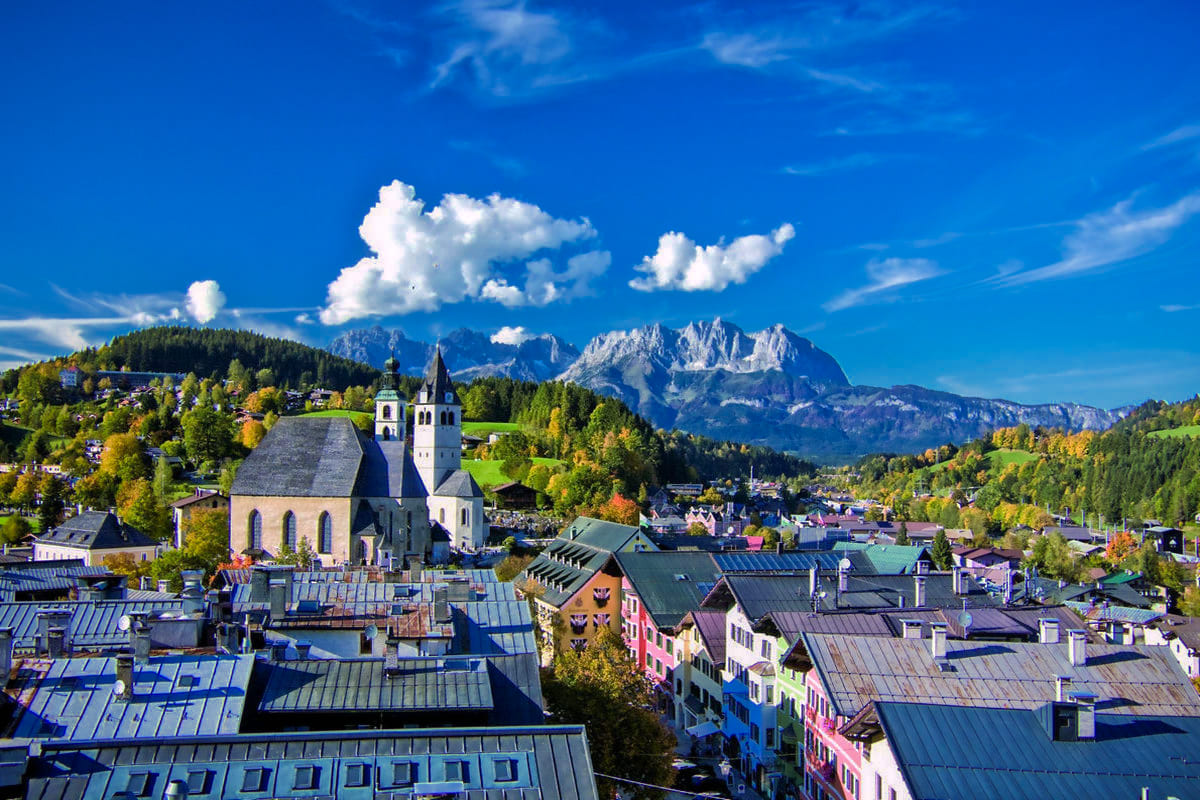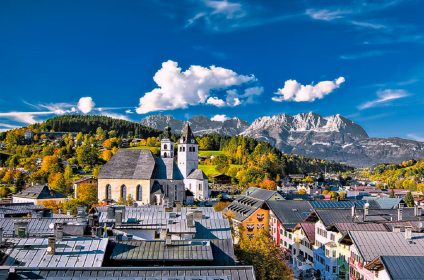How To Get In Kitzbühel

Situated in the Kitzbühel Alps, Kitzbühel is a well-known ski resort in Austria. Depending on where you are coming from, how much time and money you have, and what type of travel experience you like, there are numerous ways to get Kitzbühel. To reach Kitzbühel, fly to one of the surrounding airports and arrange a transfer, car rental, or public transit ride. From several German cities, you can also board a long-distance bus; from Austria and overseas, a train. If you are daring, you could even sail to Kitzbühel provided the water paths are accessible. Every kind of transportation has benefits and drawbacks; so, before deciding which one to use, give much thought to them.
- By car: Using well-built state and through highways, you may drive to Kitzbühel from several directions. In case of traffic congestion, you will require an emergency corridor, winter tyres and a motorway vignette. Additionally found in and around Kitzbühel are electric vehicle charging facilities.
- By train: There are three train stations in Kitzbühel: Hauptbahnhof, Centre – Hahnenkamm, and Schwarzsee. You can catch a train from Austria and elsewhere. You may also arrange comfortable travel by booking luggage delivery. Your guest card, which you acquire from your landlord, contains some train tickets.
- By plane: You can travel to one of the surrounding airports in Innsbruck, Munich, or Salzburg then use public transport, rental car, or transfer service to reach Kitzbühel. Additionally available are airport cabs to get you to your destination. Alternatively, you might travel to Vienna and then directly train to Wörgl, near Kitzbühel.
- By bus: From some German cities including Munich, Holzkirchen, and Rosenheim, you might ride a bus to Kitzbühel. The KitzSki Xpress, which comprises a first-class bus ride, breakfast, and ski pass, can also be booked.
By Plane: Aerial Access to Kitzbühel
By plane is among the fastest and most practical means of arriving to Kitzbühel. Kitzbühel is surrounded by three airports: Salzburg (80 km), Munich (160km), and Innsbruck (80km). Along with many conveniences including stores, restaurants, lounges, and Wi-Fi, these airports provide domestic and international flights. Some low-cost carriers including EasyJet, Ryanair, and Wizz Air fly to these airports as well.
Still, flying to Kitzbühel has many negatives as well. First, especially in busy seasons, you will have to schedule your flights ahead of time to prevent paying outrageous rates and restricted availability. Second, your travel time and expenses may be further increased by the arrangement of your transportation from the airport to Kitzbühel. Third, which can be demanding and unpleasant, you will have to follow the baggage and security rules of the airlines and airports.
Airport to Kitzbühel: Seamless Transfers
Should you want to fly from one of the surrounding airports, you will have to plan your way from there to Kitzbühel. Depending on your convenience and price, you can select from many airport transfer choices. The most often used airport transfer choices are listed here:
- Shuttle services: From the airport to your Kitzbühel accommodation, shuttle services—shared or private vans or buses—will carry you. You may schedule them via phone, internet, or at the airport. Usually less expensive than cabs, they are more costly than public transportation. Though slower than taxis, they are faster than public transportation. Although they are dependable and handy, you could have to wait for other people or stop several times on route.
- Private transfers: Private transfers are private vehicles or limos from the airport to your lodging in Kitzbühel. You might reserve them by phone, online, or at the airport. Usually the most costly choice, they also offer the most comfort and luxury. Since they will straight go to your destination, they are also the fastest choice. Though you could have to pay extra for taxes, ski gear, or luggage, they are dependable and handy.
- Public transport: Public transportation will get you from the airport to Kitzbühel on trains or busses. The tickets are sold online or at the airport; use them for travel to Kitzbühel. Usually the least expensive, they also provide the least comfort and convenience. Given their several stops and transfers along the road, they are also the slowest choice. Although they are environmentally friendly and dependable, you might have to haul ski gear and bags and deal with noisy and packed vehicles.
By Bus: Overland Journey
One another way to reach Kitzbühel is by bus. Certain long-distance bus companies link Kitzbühel to various German cities including Munich, Holzkirchen, and Rosenheim. Additionally reserved is the KitzSki Xpress, a unique package comprising breakfast, a first-class bus ride, and a ski pass. Usually reliable, reasonably priced, and pleasant, the bus services provide picturesque views of the countryside all along.
Still, bus travel has certain restrictions as well. First, given the bus timetables and availability might not operate every day or at convenient times, you will have to verify them. Finding the bus terminals and routes will second be challenging and time-consuming. Third, you will have to put up a protracted and occasionally rough journey that could be dull and taxing.
Bus Services: Affordable and Scenic
Should you choose to travel a long distance bus from several German cities, you will have to locate the bus companies running to Kitzbühel. From among the several popular bus lines available, you could pick:
- Munich – Kitzbühel: About two hours and fifteen minutes, this bus journey runs for roughly fifteen euros. It leaves Munich Central Bus Station and gets in Kitzbühel Centre – Hahnenkamm. The following website lets you schedule this bus service: [Munich to Kitzbühel via Bus | FlixBus].
- Holzkirchen – Kitzbühel: About one hour and forty-five minutes, Holzkirchen – Kitzbühel bus route costs roughly ten euros. It leaves Holzkirchen Train Station and gets at Kitzbühel Centre – Hahnenkam. The bus service can be reserved on [Holzkirchen to Kitzbühel via Bus | FlixBus].
- Rosenheim – Kitzbühel: This bus line runs roughly eight euros and takes one hour and fifteen minutes. It leaves Rosenheim Train Station and gets to Kitzbühel Centre – Hahnenkamm. The following website allows you to schedule this bus service: [Rosenheim to Kitzbühel via Bus | FlixBus].
The KitzSki Xpress is a unique package comprising a first-class bus journey, breakfast, and a ski pass that you can also reserve. Starting from Munich Airport, this bus route gets at Kitzbühel Centre – Hahnenkamm. Costing roughly 80 euros, it takes roughly two hours and thirty minutes.
By Car: The Road to Kitzbühel
Should you want more freedom and flexibility, you could alternatively drive to Kitzbühel. From many points, you can reach Kitzbühel using well-built state and through highways including the A12, A93, and B170. Along the trip, you can also appreciate the picturesque paths and expansive views of the mountains and valleys. If you drive an environmentally friendly automobile, you may also locate electric vehicle charging stations in and around Kitzbühel.
Driving to Kitzbühel presents several difficulties, too, though. First, you will need a motorway vignette—a toll sticker enabling usage of the Austrian roadways. You can purchase it online, at border crossings, at petrol stations. Second, you will need winter tyres, which are required from November to April, and an emergency corridor—a space you have to provide between the lanes in case of traffic congestion. Third, especially in busy times, you will have to locate parking facilities and pay for parking charges—which can be costly and limited.
Driving to Kitzbühel
Should you chose to drive to Kitzbühel, you will have to get ready for the road trip. From many points, you can reach Kitzbühel using well-built state and through highways including the A12, A93, and B170. Along the trip, you can also appreciate the picturesque paths and expansive views of the mountains and valleys. If you have an environmentally friendly car, you will also find electric vehicle charging stations around Kitzbühel.
These are some basic driving guidelines to help one reach Kitzbühel:
- Get a motorway vignette, a toll sticker letting you utilize the Austrian highways. You might find it online, at petrol stations, or at border crossings.
- From November to April, use winter tires; else, use an emergency corridor—a gap you have to allow between the lanes in case of traffic congestion.
- Look for parking spaces and pay for fines, which can be costly and rare particularly in busy times. The Park&Ride system lets you use public transportation to reach Kitzbühel after parking your car at assigned spots.
- Respect traffic laws and guidelines including drinking restrictions, seat belts, and speed caps. Additionally available is the traffic information service, which offers real-time updates on traffic congestion and road conditions.
- As you might have to show them at checkpoints or in case of an emergency, bring your driving license, car registration, insurance, and passport.
Here are some recommended stops along the way:
- Innsbruck: Innsbruck is a cultural and historical center as Tyrol’s capital as well. See the Alpine Zoo, the Imperial Palace, the Golden Roof, and the Bergisel Ski Jump.
- Kufstein: Kufstein is a charming town on the Inn river banks. See the Kaisertal Valley, the Riedel Glass Factory, and the Kufstein Fortress.
- Ellmau: At the base of the Wilder Kaiser mountain range, Ellmau is a little town with character. See the Ellmau Stone Circle, the Ellmauer Tor, and the Ellmau Ski Resort.
- St. Johann in Tirol: St. Johann in Tirol is a vibrant town with rich cultural legacy. See the Horn Park, the Museum of Tyrolean Farms, and the St. Johann Parish Church.
By Train: Railway Routes to Kitzbühel
Train is another way one could reach Kitzbühel. Kitzbühel boasts three train stations: Schwarzsee, Hauptbahnhof, and Centre – Hahnenkamm. < These stations provide frequent and consistent services and link to the main railway networks both domestically and internationally in Austria and elsewhere. Some rail tickets are included in your Guest Card, which you can acquire from your landlord; you can also arrange luggage shipping for a comfortable travel. Usually quick, pleasant, and environmentally friendly, the train provides breathtaking views of the mountain scene.
Still, using trains has its negatives as well. First, especially in peak seasons, you will have to reserve your train tickets ahead of time to prevent paying outrageous rates and restricted availability. Second, which can be difficult and time-consuming, you will have to locate the rail stations and lines. Third, you will have to haul your ski gear and bags, which can be weighty and taxing.
Train Travel: Scenic Rail Routes
Should you choose to ride a train to Kitzbühel, you will have to locate the train stations and choose the lines that fit for your trip schedule. Kitzbühel boasts three train stations: Schwarzsee, Hauptbahnhof, and Centre – Hahnenkamm. < These stations provide frequent and consistent services and link to the main railway networks both domestically and internationally in Austria and elsewhere. Some rail tickets are included in your Guest Card, which you can acquire from your landlord; you can also arrange luggage shipping for a comfortable travel. Usually quick, pleasant, and environmentally friendly, the train provides breathtaking views of the mountain scene.
The following picturesque train lines head for Kitzbühel:
- Vienna – Wörgl – Kitzbühel: This train line from Vienna – Wörgl – Kitzbühel runs roughly four hours and thirty minutes and costs around fifty euros. It leaves Vienna Central Station and gets at Kitzbühel Hauptbahnhof. This direct train winds across the stunning Austrian landscape and the UNESCO World Heritage Site Semmering Railway.
- Zurich – Innsbruck – Kitzbühel: About five hours and fifteen minutes, Zurich – Innsbruck – Kitzbühel train line costs roughly eighty euros. way leaves Zurich Central Station and makes way to Kitzbühel Hauptbahnhof. This train travels the breathtaking Swiss and Austrian Alps, passing the Arlberg Pass and the Ziller Valley and needs one transfer in Innsbruck.
- Munich – Rosenheim – Kitzbühel: This train line, Munich – Rosenheim – Kitzbühel, runs roughly two hours and fifteen minutes and costs around 25 euros. It leaves Munich Central Station and finds its way to Kitzbühel Centre – Hahnenkamm. This train crosses the picturesque Bavarian and Tyrolean scenery along the Inn and the Chiemsee and calls one stop in Rosenheim.
































